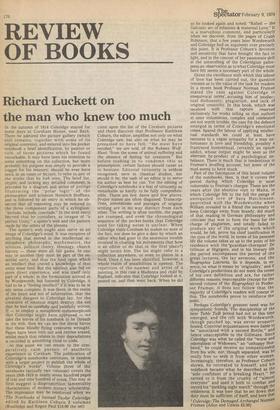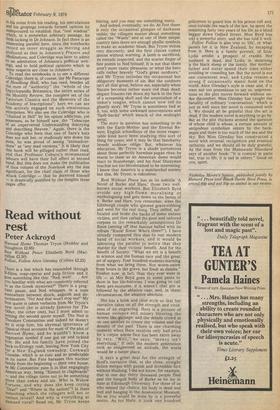Richard Luckett on the man who knew too much
In the autumn of 1814 Coleridge stayed for some days at Corsham House, near Bath. There he admired the picture gallery (which still remains, together with some of its original contents), and entered into his pocket notebook a brief identification, by painter or title, of those pictures which he found remarkable. It may have been his intention to write something on the collection, but more probably his purpose was simply to provide a trigger for his memory, should he ever have need, in an essay or lecture, to refer to any of the works that he had seen. The brief list, cryptic and lacking any detailed comment, is preceded by a diagram and series of jottings illustrating the "polar logic" of the philosopher and scientist Heinrich Steffens, and is followed by an entry in which he observes that all reasoning may be reduced to the three component parts of a syllogism; "seclude, include, conclude." In the next entry beyond that he considers, as images of "a perfect Unity," a spider's web and the pattern made by the orbits of the planets. The spider's web might also serve as an image of Coleridge's mind. It was receptive of anything that moved in the intellectual atmosphere: philosophy, mathematics, the sciences, political theory, theology, church history — these were all fair game. In one way or another they must be part of the essential unity, and thus the food upon which an intellect that craved a knowledge of that unity must feed. But the intellect also fed on more direct experience, and was itself only part of a whole; in the formulation arrived at by Wordsworth, but fostered by Coleridge, it had to be a "feeling intellect" if it was to be in any sense complete. It was there, in the realm of the heart and not of information, that the greatest dangers to Coleridge lay, for the creatures of emotion might destroy the net that he had so carefully and painfully woven. If — to employ a metaphoric metamorphosis that Coleridge might have approved — we take the leaves of his notebook to be threads in the web, then we can see the literal havoc that these blindly flying creatures wrought. Pages have been torn out and entries erased, whilst much that relates to their depradations is recorded in something close to code.
At this point we can return to the comparatively calm pursuit of aesthetic experience at Corsham. The publication of Coleridge's notebooks continues, in tandem with a larger project to publish the whole of Cbleridge's works*. Volume three of the notebooks (actually two volumes) covers the years 1808-1819 in nearly seven hundred pages of text and nine hundred of notes. This may at first suggest a disproportion lamentably characteristic of modern literary scholarship. The impression may be reinforced when we *The Notebooks of Samuel Taylor Coleridge edited by Kathleen Coburn 2 volumes (Routledge and Kegan Paul £18.00 the set)
come upon the list of the Corsham pictures and there discover that Professor Kathleen Coburn, the editor, amplifies not only on what Coleridge saw, but also on what he may be presumed to have felt. "He must have recoiled," we are told, of the Rubens WolfHunt, "from the scene of animal suffering and the absence of feeling for creatures." But before rushing in to condemn this as presumption, certain factors should cause us to hesitate. Editorial virtuosity is seldom recognised, save in classical studies, nor should it be; the task of an editor is to serve his author as best he can. Yet the editing of Coleridge's notebooks is a feat of virtuosity so remarkable as hardly to be fully comprehensible. There are few dates and few places. Proper names are often disguised. Transcriptions, annotations and passages of original writing are in no way distinct from each other. The writing is often terrible, the pages are cramped, and even the chronological sequence of the pocket-books that Coleridge used for taking notes is unclear. When Coleridge visits Corsham he makes no note of the fact, nor does he give a date by which an editor who had gone to the enormous trouble involved in charting his movements (but how is an editor to do that in the first place?) might locate him. The list might refer to a collection anywhere, or even to plates in a book. Once it has been identified, however, a whole realm of possibilities is opened. The repetition of the number and artist of a painting, in this case a Madonna and child by Raphael, indicates that Coleridge looked at it, passed on, and then went back. When he did
so he looked again and noted: "Rafael — the Galvanic arc of infantine & maternal Love." It is a marvellous comment, and particularly when we discover, from the pages of Crabb Robinson, that a few years later Wordsworth and Coleridge had an argument over precisely this point. It is Professor Coburn's devotion and sensitivity that have brought the fact to light, and in the context of her passionate skill in the unravelling of the Coleridgian palimpsest an observation as to what Coleridge must have felt seems a necessary part of the whole.
Given the excellence with which this labour of love has been carried out, the question remains as to the value of the task for readers. In a recent book Professor Norman Fruman stated the case against Coleridge in unequivocal terms', accusing him of intellectual dishonesty, plagiarism, and lack of original creativity. In this book, which was received with that rapture reserved exclusively for works telling us that authors at once voluminous, complex and celebrated are not worth trouble, the case for the defence emerged in terms of Coleridge's emotional crises. Spared the labour of applying intellectual standards we could at least have recourse to a vague sympathy for a man unfortunate in love and friendship, possibly a frustrated homosexual, certainly an opium addict, whose output might be seen as the aberrant by-product of a psychological imbalance. There is much that is tendentious in Fruman's levelling account, but some of the mud seems to have stuck.
Part of the fascination of this latest volume of the notebooks, then, is that it covers the period during which Coleridge is most vulnerable to Fruman's charges. These are the years after the abortive visit to Malta, in which Coleridge felt to the full the pangs of unrequited love of Sara Hutchinson, quarrelled with the Wordsworths when William revealed to a friend the necessity to keep Coleridge away from brandy, did much of that reading in German philosophy and criticism that was to form the basis for the charge of plagiarism, and totally failed to produce any of the original work which would, he felt, prove his chief justification in the eyes of the world. In terms of his personal life the volume takes us up to the point of his residence with the 'guardian-therapist' Dr Gillman at Highgate, and in his literary life the period encompasses the period of the great lectures, the lay sermons, and the Biographia Literaria. So it depends, in essence, on what is meant by 'originality,' and if Coleridge's productions do not meet the terms of his own definition and are, for rather different reasons, unacceptable (except for the second volume of the BiOgraphia) to Professor Fruman, it does not follow that the majority of Coleridge's readers will concur this. The notebooks prove to reinforce the point. Perhaps Coleridge's greatest need was for sympathetic friends. The discipleship of the later Table Talk period had not at this time emerged, and the rift with Wordsworth, though patched up, was never properly healed. Convivial acquaintances were liable to be "associated with a second Bottle," and hence unacceptable to the Gillmans. Since Coleridge was what he called the "worst and miserablest of Widowers," an "unhappy Husband," he could receive no companionshiP from his wife, nor, though separated, was he really free to seek it from other women. Increasingly, therefore, as Professor Coburn shows, he retreated to himself, and his notebook became what he described as the "sole confidant of a breaking Heart." He turned to it from the cruelty of "almos,t everyone" and used it both to combat ano record his "darkling night march" through the wilderness. It was here that he set down that duty must be sufficient of itself, and here that Coleridge: The Damaged Archangel Norrnan Fruman (Allen and Unwin 0.50) in his notes from his reading, his speculations and his gropings towards formed opinion he endeavoured to establish that "real wisdom" Which, in a somewhat arbitrary passage, he finds lacking in Dr Johnson. In fact there is an interesting parallel here, since the notebooks ,i-ecord an inner struggle as moving and .profound as that in Johnson's Prayers and 'Meditations, and Coleridge was later to admit ito an admiration of Johnson's political writwigs, and to hold political opinions which in some respects are close to Johnson's.
To read the notebooks is to see a different Coleridge; there is, of course, the Mr Panscope of Headlong Hall, who has read, besides all the men of "authority" the "whole of the Encyclopaedia Britannica, the entire series of the Monthly Review, the complete set of the Variorum Classics and the Memoirs of the Academy of Inscriptions"; here we can see him actively engaged on such omnivorous enterprises. We also see the Coleridge who is chained in Hell" by his opium addiction, yet Possesses, as he himself saw, the "Telescope of an unperverted Understanding descrying and describing Heaven." Again, there is the Coleridge who feels that one of Sara's hats does not suit her, or studiously sets down his Puns; he was proud of seeing "animadversions" as "any mad versions." It is likely that this book will be pillaged rather than read, and that Professor Coburn's monumental labours will have their full effect at second„ hand. But this does not make the publication of thos volume of the Notebook any the less Significant, for the chief claim of those who attack Coleridge — that he deceived himself — is drastically qualified by the insights these Pages offer.



































 Previous page
Previous page